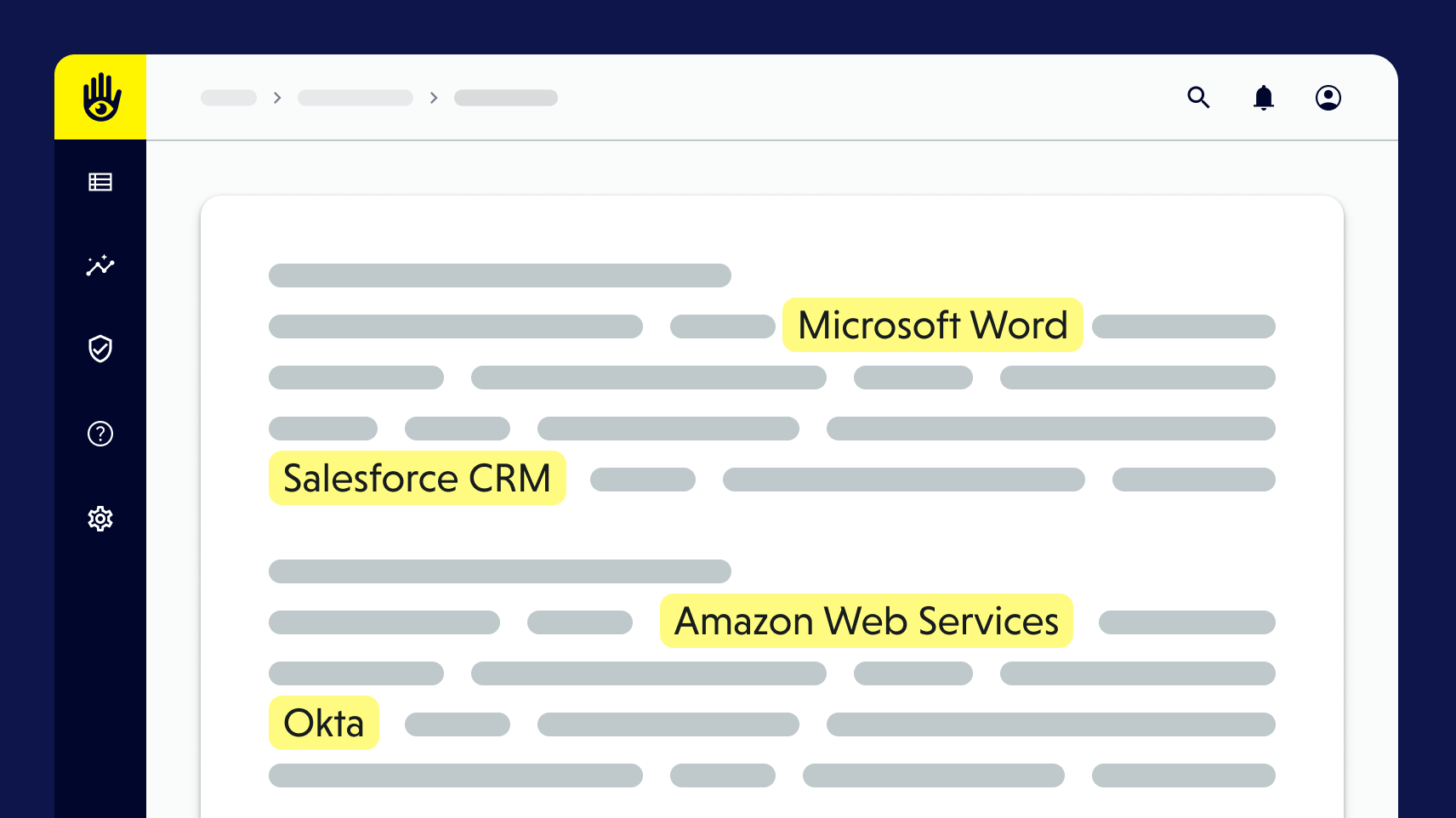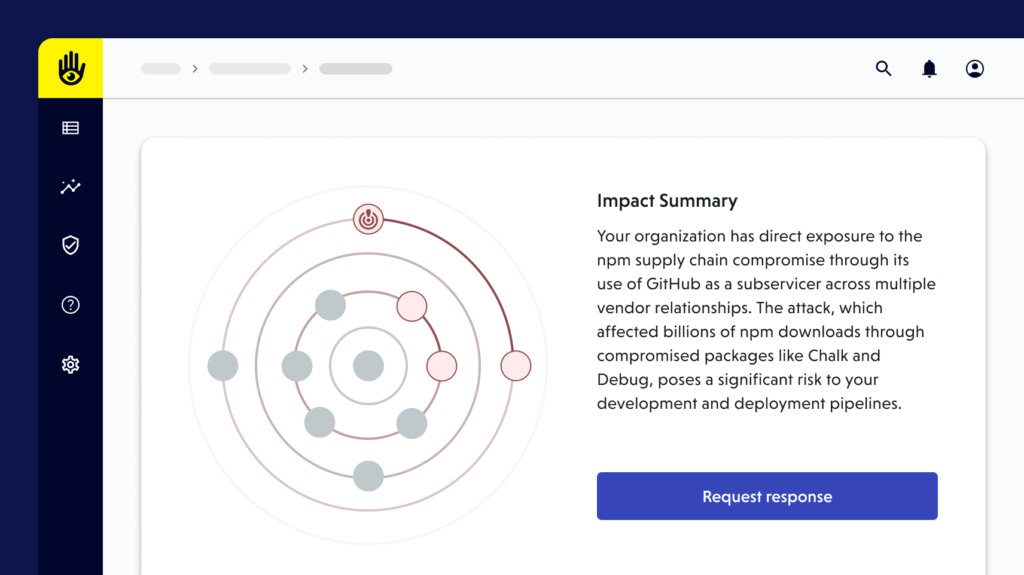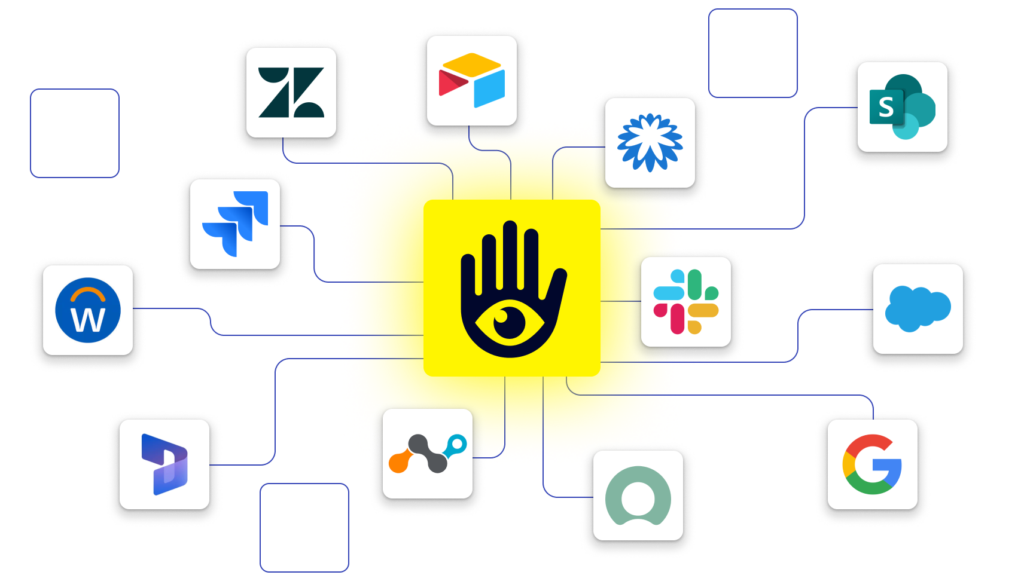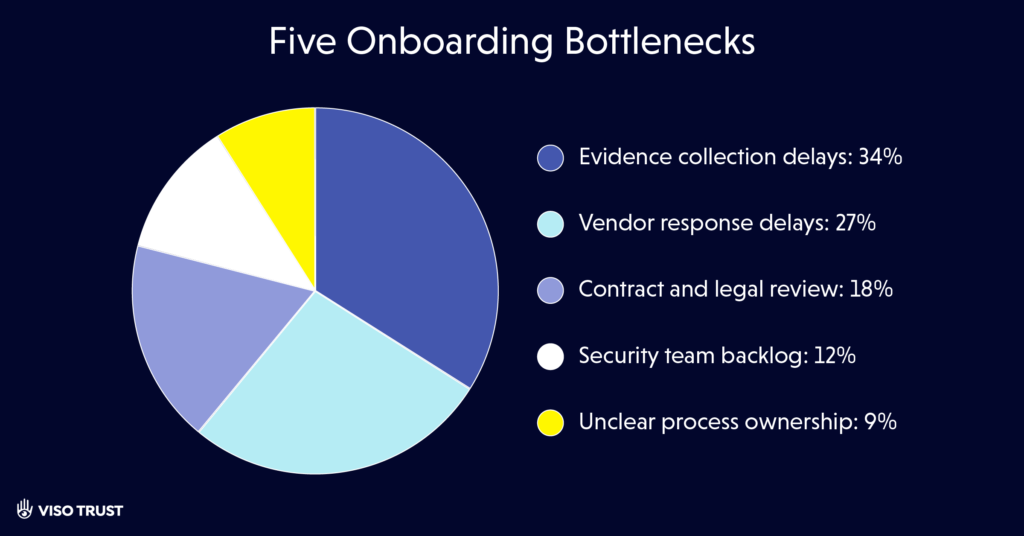Fourth-party risk management
Managing your own vendors is only part of the picture. Every third-party you rely on brings its own network of subcontractors—4th party vendors—that can introduce risk you don’t directly control. From cloud providers embedded in SaaS platforms to niche service firms buried deep in the supply chain, these fourth-nth parties create hidden dependencies that traditional assessments rarely uncover.
The challenge is visibility. Most organizations struggle with vendor discovery, vendor mapping, and understanding how much exposure comes from fourth-party risk. Without that insight, you can’t fully assess resilience or compliance across your ecosystem.
That’s where fourth-party risk management comes in: identifying indirect vendors, tracking vendor dependency risk, and managing nth-party risk so your business isn’t blindsided by weaknesses outside of your immediate third-party relationships.
What is fourth-party risk management?
Fourth-party risk management is the practice of identifying and monitoring the vendors that your own vendors rely on. These indirect providers—often called sub-processors or downstream vendors—don’t appear in your contracts, but they still play a role in delivering the services your business depends on.
Where traditional third-party risk management stops at direct supplier oversight, fourth-party risk management goes a layer deeper. The goal is to map your extended supply chain, uncover hidden dependencies, and evaluate how those relationships might affect your security, compliance, or operations.
This expanded view helps organizations spot vulnerabilities that would otherwise remain invisible—such as a cloud service your SaaS provider depends on, or a subcontractor handling sensitive data for a payroll processor. By bringing these connections into focus, fourth-party risk management enables better decisions about vendor selection, resilience planning, and overall risk posture.

Why fourth party risk matters
Hidden exposure
Sub-processors and downstream providers often sit outside your line of sight. Without effective vendor discovery, these high-risk relationships remain invisible—creating blind spots in both security and compliance.
Regulatory pressure
Oversight doesn’t stop at direct vendors. Regulations like GDPR, DORA, HIPAA, and NYDFS now expect organizations to account for dependencies and sub-vendors in their risk programs.
Incomplete risk scoring
If you only assess third parties, you’re only seeing part of the picture. Excluding fourth-party relationships can distort risk scores and leave leadership with gaps in oversight.
Inefficient processes
Relying on surveys or spreadsheets to map vendor ecosystems is slow, error-prone, and impossible to scale as relationships multiply.
Types of fourth-party risk
Fourth-party risk becomes real when it disrupts your business. While exposures can take many forms, most fall into a handful of clear categories: cyber, compliance, operational, and reputational. Each carries direct consequences that organizations can’t afford to ignore.
Cyber risk
A data breach, ransomware attack, or vulnerability at a downstream provider can quickly ripple back to you. Even if your systems remain untouched, you may lose access to critical services, face incident response costs, or be forced to explain to customers how their data was exposed through a sub-processor.


Compliance risk
When a fourth party mishandles sensitive data or lets certifications lapse, your organization may still bear the fallout. Regulators and auditors don’t stop at your immediate vendors—they hold you accountable for the full chain. The result can be fines, failed audits, or barriers to doing business in regulated markets.
Operational and supply chain risk
A disruption at a fourth party can cascade into your own operations. Outages, subcontractor failures, or single points of dependency—like a vendor tied to one cloud provider—can lead to downtime, delayed services, or broken commitments to customers.


Reputational risk
Negative headlines don’t distinguish between “your vendor” and “your vendor’s vendor.” A fourth-party incident—whether it’s a breach, unethical practice, or public service failure—can damage your credibility and erode customer trust by association.
Breaking risk into these categories helps organizations move beyond static questionnaires toward a living, dynamic view of vendor posture. With AI-powered assessments, these risks aren’t just identified—they’re continuously monitored, contextualized, and prioritized so teams can act before small issues become major problems.
Business outcomes of fourth-party risk management
The value of fourth-party risk management goes beyond uncovering hidden vendors. Organizations that build visibility into their extended supply chain achieve:
Better vendor discovery
through mapping tools that identify sub-vendors and highlight dependencies you may not control directly.
Reduced blind spots
by surfacing high-risk sub-processors, cloud providers, and other fourth-party vendors that could impact security, compliance, or continuity.
Stronger compliance posture
with oversight that extends to nth-party risk, aligning with expectations in GDPR, DORA, HIPAA, and other frameworks.
More accurate risk scoring
by factoring both direct and indirect exposures into board and regulator reporting, delivering a truer picture of enterprise risk.
Resilient supply chains
where hidden dependencies are monitored and managed, minimizing the chance that a downstream failure disrupts operations.
These outcomes shift fourth-party vendor risk management from a theoretical exercise to a practical safeguard. By understanding how 3rd party vs 4th party relationships connect, organizations build the trust, agility, and resilience needed to navigate today’s complex vendor ecosystem.
Best practices for fourth-party risk management
Managing fourth-party risk can feel overwhelming, especially when vendor networks run several layers deep. The key is to focus on visibility and prioritization, not on trying to control every subcontractor relationship. Here are some best practices to guide a stronger monitoring program:
Start with vendor discovery
Begin by mapping your third-party vendors and identifying their key sub-processors. Many platforms now automate this process, giving you visibility into fourth-nth parties without endless surveys and spreadsheets.
Prioritize critical dependencies
Not every sub-vendor poses equal risk. Focus your efforts on fourth-party vendors that process sensitive data, support regulated workloads, or provide services that your operations can’t function without.
Integrate into existing TPRM
Don’t build a separate program. Extend your existing third-party risk management workflows to account for vendor dependency risk. Use the same evidence collection, scoring, and reporting methods for consistency.
Leverage continuous monitoring
Risks shift quickly. Use automated tools to track compliance certifications, incidents, and operational changes across indirect vendors, reducing blind spots and lag time.
Communicate clearly to leadership
Boards and regulators increasingly expect proof of oversight. Make sure your reports highlight 3rd party vs 4th party exposure in plain language, with data that is defensible and audit-ready.
By following these practices, organizations move from reactive discovery to proactive control—managing fourth-party risk in a way that strengthens resilience without creating unmanageable overhead.
How VISO TRUST delivers full nth-party visibility
VISO TRUST takes the guesswork out of fourth-party risk management by automating discovery, mapping, and monitoring across your extended supply chain. With AI-powered analysis, you get clear, actionable visibility into vendors you don’t contract with directly—but still rely on.

Automatic vendor discovery
Surface fourth parties and sub-processors from trust portals, public disclosures, and uploaded artifacts without manual chasing.
Dynamic vendor mapping
Visualize the connections between your organization, your vendors, and their vendors through an interactive graph that updates as relationships change.
Fully continuous monitoring at scale
Apply the same ongoing monitoring and scoring you use for third parties to all identified nth-party risks, reducing blind spots.
Audit-ready evidence
Generate exportable maps and documentation that show clear oversight of vendor dependencies—ready for boards, regulators, or auditors in seconds.
Integration-ready
Streamline and automate complex workflows and decision-making across your entire enterprise stack – seamlessly integrating with tools like Jira, Coupa, ServiceNow, Archer, Slack, Okta, and thousands more.

Benefits of fourth-party risk management with VISO TRUST
Complete visibility
Uncover and map every vendor dependency risk across your entire supply chain for a full picture of exposure.
Faster compliance
Meet DORA, GDPR, HIPAA, and NYDFS requirements for third party vs fourth party oversight.
Proactive risk reduction
Spot high-risk sub-vendors early – before they disrupt operations or create compliance gaps.
Audit-ready reporting
Generate dynamic reports showing every relationship and risk score — no manual prep.




